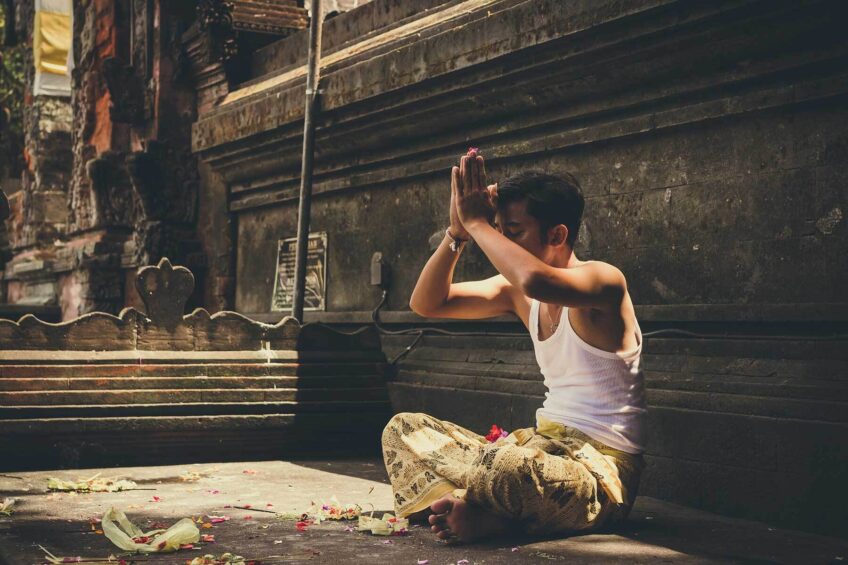What does yoga literally mean? Is it a personal experience or much more?
There's a lot to unpack with the meaning of Yoga. However, what does yoga mean? Is the definition universal, or is yoga a personal experience?

Ask any person who practices yoga what yoga actually means, and you’ll get a different answer every time (almost).
This used to annoy me when I started doing yoga more regularly because I like facts and definitive answers, not wishy-washy, half-baked personal interpretations.
But, with a few years under my belt, I’ve changed my tune.
It is an entirely personal journey, and the yoga experience differs for everyone.
For me, yoga is about balance and flow; it’s about countering the busyness of the world and the hours of sitting behind a desk. It’s very much the ying to my life’s yang. So, now, words like ‘union’ and joining make more sense to me.
I’ve also uncovered more about the actual meaning of yoga through conversations with other yogis who are much further down the road. So, I’ll try and unpack and condense some of the different answers that I’ve had to the critical question of, “What is the actual meaning of yoga?”
What is the literal meaning of yoga?
Yoga comes from the word Yuj in Sanskrit, which means to join, to unite or to yoke, and the yoga scriptures refer to the practice of yoga leading to the union of individual consciousness with the Universal Consciousness.
This joining offers the perfect harmony between the mind and the body and between man and nature. Whew! That’s a bit of a mouthful, so let’s break it down a bit…
Your yoga journey is actually one of self-realization whereby you are encouraged to overcome all suffering to experience freedom (according to Kaivalya) or a state of liberation (according to the teachings of Moksha).
This applies to every area of our lives, and living in a healthy and harmonious state is our top priority. So, if you’ve joined a class to get better at touching your toes, that is an excellent place to start, but it’s just the tip of the iceberg!
If we circle back to the literal meaning of the word yoga, meaning “union,” it can be interpreted on four different levels:
- Philosophical understanding – where you look at your limited self relative to the absolute self.
- Religious understanding – the union between your soul and the Infinite Spirit.
- Psychological understanding – becoming united with your true self so that you no longer live in conflict with yourself.
- Emotional understanding – rather than being swayed by likes and dislikes, you can take the world on its terms and remain unmoved.
As I mentioned, this is a process, so if you’re new to yoga, there’s still a lot to discover, but don’t worry about rushing through. There’s plenty of time.
What is the original meaning of yoga?
Consider the saying “Yogas chitta vritti nirodha” (“Yoga is the neutralization of the vortices of feeling”) by the ancient sage Patanjali. His philosophy was based on the idea that if you could quieten your ego-directed feelings, you would realize that you are one with the Infinite. Patanjali understood that his reality remained limited because he continued to focus on his limitations.

He went on to collate the Yoga Sutra around 2,000 years ago. It’s a collection of 195 statements that together offer a philosophical framework for yoga. In it, he defines the eight limbs of yoga as being:
- Yamas (restraints)
- Niyamas (observances)
- Asana (postures)
- Pranayama (breathing)
- Pratyahara (withdrawal of senses)
- Dharana (concentration)
- Dhyani (meditation)
- Samadhi (enlightenment, absorption)
As we begin to explore these eight limbs, our behaviors and interactions with the outer world are transformed, and our inner focus moves us towards samadhi or enlightenment.
Across the world, most of us who practice yoga are engaged in the third limb, called asana, which is the system of physical poses that help to purify and strengthen the body and prepare it for meditation.
Where does yoga come from?
Yoga, particularly in the Western world, is thought of by most as a physical journey (hatha yoga), but yoga is a spiritual discipline first and foremost.
True spiritual yoga is an ancient Indian philosophy that dates back over 5,000 years and originated in the Indus Valley Civilization. The father of classical Ashtanga yoga (not Sri K. Pattabhi Jois’ Ashtanga yoga) is said to be Patanjali, who wrote the Yoga Sutra and captured the philosophy of the eight-limbed path.
Yoga offers an approach to living more consciously, and this spiritual discipline can take many different forms, the most well-known of which are gyana yoga, raja yoga, bhakti oga, and karma yoga.
What does Hatha mean?
Hatha means forceful or willful, and hatha yoga refers to the physical exercises and poses that align your body to allow energy to flow freely. There is also the translation of Hatha as meaning “ha” (sun) and “tha” (moon), which refers to the balance of masculine (active, hot) and feminine (receptive, cool).
Therefore, the practice of hatha yoga moves us along the path toward balance and the union of opposites. In our physical bodies, this is reflected in balancing strength and flexibility with the effort and surrender needed for each pose.
This makes hatha yoga a powerful way to begin the process of self-transformation as we focus on our breath, slow our racing minds, and learn to be present in the moment.
What about the physical asanas and meditations of yoga?
Most of us think of this when we hear the word yoga. They are designed to help you grow, maintain calm, and reconnect with your true self. Called Hatha yoga, these practices can also help with anxiety, physical pain, flexibility, energy and vitality, protection from injury, and much more.
But the goal of yoga is much bigger than flexibility; it’s about harmony with the universe. Hatha yoga, the yoga system of physical exercises and breathing control, is a preparatory process to get the body ready to sustain higher energy levels. This process starts with the body, then the breath, then the mind, and finally, the inner self.
Is yoga a religion?
Yoga is the practice of moving towards inner well-being and, as such, does not adhere to a religion or belief system, nor is it specific to any one community. So, regardless of your faith, ethnicity, or culture, you can practice yoga and reap the benefits.

Some different philosophies and traditions accompany the different schools of yoga (such as Jnana-yoga, Bhakti-yoga, Karma-yoga, Dhyana-yoga, and more), many of which are influenced by Hinduism and Buddhism.
Still, you don’t need to follow those paths to practice yoga. Importantly, putting aside your own religious beliefs to practice yoga is unnecessary.
My Thoughts?
I still have so far to go in my yoga journey, and I know that there’s a lot more to learn (the more I learn, the more I realize how little I understand). Where I’m at now, it’s encouraging me to know that it is a process of joining and unity, which starts with the body.
I think in today’s uncertain times, it’s more important than ever to be working towards something that draws us towards our true selves and can join us with others.
I like the explanation that Hatha (the physical yoga most familiar with) is the right place to start. I’ve taken the first step towards achieving unity by preparing my body through regular yoga practice. And from there, I can progress to my breath, mind, and inner self.
It’s also an exciting journey to have started because there is so much more to discover. It’s not just a case of perfecting my downward dog but, instead, a pilgrimage that I will be on for the rest of my life.
Tony Lee, MS, RD
Tony Lee, RD, MS, is a highly qualified and accomplished Registered Dietitian with a Master’s Degree in Nutrition Sciences. Tony brings over two decades of experience in dietetics, specializing in sports nutrition. Interests include studying all aspects of wellness, fitness, genetics, and peak health performance.










